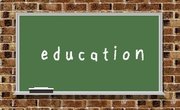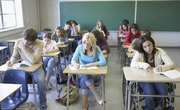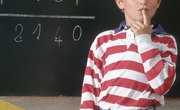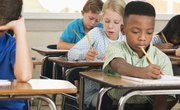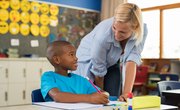Every student with a special education ruling must have a new Individualized Education Plan (IEP) written by a special education teacher for each new school year. An integral part of this IEP is the section which contains goals and objectives for the upcoming school year. Goals and objectives should be individualized to meet each student's specific needs. Also, goals and objectives should be measurable and attainable. In addition, goals and objectives should take into consideration the student's current placement, whether it is in the general education classroom or in a self-contained classroom.
First, determine how the school district or state department of education wants goals to be written. Many state education departments and school districts have guidelines about how to write goals and objectives. Usually, the special education director will give special education teachers specific criteria for writing goals and objectives on IEPs.
Next, determine the student's current performance level. Special education teachers should review classroom grades, district and state testing and any other assessments conducted during the school year. This information should be used to ascertain where the student is currently performing so that goals and objectives can be written to continue to move the student forward academically or functionally or both.
The special education teacher should also consider the student's current educational placement. The current trend in special education is to have as many children included in the regular classroom as possible. These inclusion students will most likely be working on goals similar to their peers, but possibly simplified or on a lower level. Some more severely disabled students continue to be taught in self-contained classrooms. These students may be working on goals and objectives pertaining to functional skills and daily living skills as well as some academic skills.
If the student is in a regular education classroom, consult with the general education teacher about goals. The regular classroom teacher's input is essential because he works with the student daily and can give vital information about how well the student is performing in her current grade level. The regular classroom teacher and the special education teacher should collaborate about goals and objectives to ensure that the goals are appropriate for each individual student.
The special education teacher should propose measurable goals and objectives. Goals should be written to include how the goals and objectives will be measured. For example, the special education teacher could write: "The student will sequence story pictures correctly with 80 percent accuracy." Another way to write the same goal might be to say: "The student will sequence story pictures correctly 8 out of 10 times." Writing goals in this way allows for teachers to determine how well the student is succeeding in meeting the goals or objectives set forth in the IEP.
Goals and objectives should be attainable for the individual student. If the special education teacher thoroughly reviews student work samples and all assessment data, then she should be able to determine what type of goals will be realistic for the student. Goals and objectives should not stay the same year after year and should not be too easy for the student. Goals and objectives should provide somewhat of a challenge for the student to keep him engaged in learning, but at the same time they should be reasonable as well.
The special education teacher should conduct an annual IEP meeting with the student's parents, other involved teachers, and the school's administrator to discuss and approve proposed goals. If there are concerns addressed about the goals, then goals can be revised to satisfy all involved parties. However, the special education teacher should still ensure that the goals are measurable and attainable for the individual student.
Related Articles
Writer Bio
Based in Laurel, Miss., Melody Morgan Hughes covers topics related to education, money and health. She has a Bachelor of Arts in English education from the University of Southern Mississippi, a Master of Education from William Carey University and a Master of Education from Nova Southeastern University.





